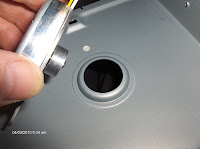

The idea of using a 20" bicycle wheel occurred to me long time ago - just recently I figured out how to make it generator without belts or special PM generator. It uses a front fork from a bike. I have it stuck into a pipe in a ground. Attached is a a wood lattice about 1/2" x 1/2" about 3 ft long. The tail is an old for sale sign which is light. I used duct tape between two spokes and every second pair is skipped.
I had it spinning in the wind for about a week without magnets or coil (generator). It starts turning in about 5km/h breeze.
The idea is that you could have 9 or 18 magnets (and coils mounted on another stationary rim larger around without spokes).


Mounting of magnets from old hard drives. I had 3 magnets so I spaced them equally around the wheel and centered. One coil from a 12 V solenoid is used instead of the one I wound. It is 270 ohms with a voltage doubler circuit (see above).
Making the coil. Coil, the gap - spacing between magnet and coil is critical.
Using a transformer primary; unwinding using cordless drill,

winding.
Finished coil. Mounting coil between forks, above magnet.

This windmill generates about 13VDC (no-load), low current, enough to flash a bright white led when one of the magnets passes the coil. The voltage with LED hooked up stays around 2.4V, it's about 2.5-2.6V when it flashes. It starts flashing as soon as it starts turning about 4km/h. At about 15km/h it's almost steady on.

Coil mounted between forks on a piece of aluminum bracket attached to wood lattice for tail. Fork in down position, seen is the coil wrapped in thick rubber, the electrolytic caps and diodes. After it was done connections and exposed leads are hot glued to protect from the elements.
There was so much juice available that I modified the circuit - adding charging for remote temperature sensor that is close by. The temp. sensor used the expensive ($20 for 4) extreme temperature lithium-ion non-rechargeable batteries that didn't last long enough.
I put in rechargeable batteries from a solar light 2 x 1.5v NiCads, added couple wires to battery socket and a connector. Connected a wire from generator and plugged it in. Added a diode to led circuit to allow ~0.5v higher voltage for battery charging to ~3V. Intend to add the solar light to the circuit as well.
I will also add a video when it will be windy again. - here it is at 6km/h & 12km/h
In this picture you can see the wheel generator, the wind-anemometer, temperature sensor below it, the solar light on top of smaller post and the led flashing light just below it.


Latest circuit. I found out that parallel circuit of light and temp sensor didn't provide enough current for light. The solution is series connection, where the LED serves as a charge indicator and charge controller. Also I connected a solar light battery in series also to charge the 1.5V NiCad in it. I also have a remote anemometer that has a Lithium-Ion non-rechargeable battery in, when it dies (it lasts a long time versus the remote temp. sensor) to the circuit.
I will draw up the circuit in gEDA schematic editor (Linux).

 Picture is worth a 1000 words, so I started with pictures and will add notes as required. Started with a stepper motor from and Ooold 5 1/4" floppy drive - those steppers are big and heavy - good for generators.
Picture is worth a 1000 words, so I started with pictures and will add notes as required. Started with a stepper motor from and Ooold 5 1/4" floppy drive - those steppers are big and heavy - good for generators.

 thing I wanted from the CD Rom for now is the spindle to fit the CD Rom disk opening and be able to attach it to the motor.
thing I wanted from the CD Rom for now is the spindle to fit the CD Rom disk opening and be able to attach it to the motor. Using the CD Rom cover to mount the stepper motor - generator to it.
Using the CD Rom cover to mount the stepper motor - generator to it.
 shown mounted with 2 self-taping screws.
shown mounted with 2 self-taping screws. !
! Now gluing the spindle (cd holder) to the generator.
Now gluing the spindle (cd holder) to the generator.










